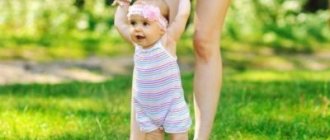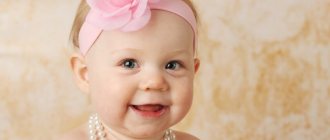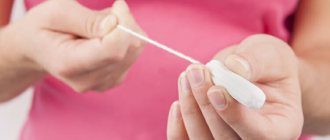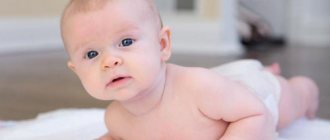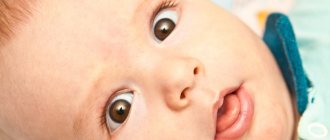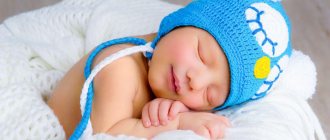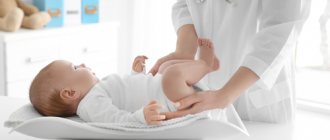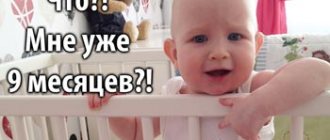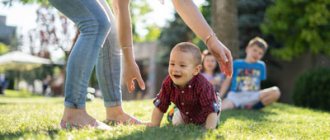Content
- 1 Spinal motor automatisms 1.1 Protective reflex of the newborn
- 1.2 Support reflex and automatic gait of newborns
- 1.3 Crawling reflex (Bauer) and spontaneous crawling
- 1.4 Grasp reflex
- 1.5 Galant reflex
- 1.6 Perez reflex
- 1.7 Moro reflex
- 2.1 Sucking reflex
Congenital reflexes of a newborn
- Newborn
- Physiological reflexes
- Sucking reflex
Newbornhood is the only period in a person’s life when natural, instinctive forms of behavior can still be observed in their pure form. Therefore, the answer to the question “what does nature give to a child?” can be obtained by studying exactly this age.
A baby is born with a certain supply of innate unconditioned reflexes, that is, automatic, involuntary responses to certain external stimuli. And although his nervous system is still far from formed, it is ready to adapt the body to external conditions.
Among the innate reflexes of a newborn, three groups can be distinguished: physiological, atavistic and orientation reflexes.
A child is born with reflexes that are absolutely necessary for his physical survival in the outside world. These are physiological reflexes. So, immediately after birth, reflexes are activated that ensure breathing and blood circulation. This group also includes the so-called protective reflexes, which protect the body from dangerous and too strong influences.
Thus, severe skin irritation (for example, an injection) causes the child to withdraw his arms or legs; a sharp increase in light brightness causes constriction of the pupil (pupillary reflex); In response to a flicker of light or a puff of air, the baby squints or closes his eyes (blink reflex). These reflexes are absolutely necessary for survival and persist throughout a person's life.
The most important vital reflex of a newborn is the sucking reflex. If you touch an object (for example, a finger) to the baby's mouth, he immediately begins to suck on it. And if you touch his cheek, he will immediately turn his head towards the irritant and with his mouth open will look for it. This turns on the search reflex. These reflexes ensure that the child is ready for a new type of nutrition.
However, not all reflexes of a newborn have vital adaptive significance. They represent the inheritance received by the child from his animal ancestors. Nothing human develops on their basis. These are the so-called atavistic reflexes. The most striking example of this is the so-called Robinson reflex (or clinging reflex). Touching a baby's palm produces a grasping reaction that is surprisingly strong for a newborn.
For example, if you touch his palms with your fingers, he will grab them so tightly that he can hang on to your fingers like a monkey. These also include the “stepping reflex” - if the baby’s foot touches any surface, he begins to make stepping movements with both legs, as if “walking.” Reflexes that are equally useless for the life of a newborn include the crawling reflex (touching the soles of the feet causes a reflex repulsion); arm-throwing reflex (or Moro reflex - if the baby is in danger of falling or in response to a strong sound, he sharply raises his arms up and quickly lowers them, while his palms seem ready to grab something). Relatively recently, the swimming reflex of a newborn was discovered: if he is lowered into water, he will not drown, but will flounder and stay on the water.
Did not you find what you were looking for?
Teachers rush to help
Diploma
Tests
Coursework
Abstracts
It is characteristic that most atavistic reflexes fade away already in the first half of life. For example, the Robinson reflex weakens significantly by the fourth month of life, before a purposeful act of grasping occurs. The step reflex disappears at 3-4 months, long before the child begins to walk. The crawling reflex when resting on the soles is also not the basis for independent movement in space. As observations have shown, infant crawling begins not with pushing off with the legs, but with movements of the arms. Unconditioned reflexes of newborns do not by themselves ensure the emergence of human forms of behavior. In contrast, a set of unconditioned reflexes of young animals is a necessary natural basis for the behavior of an adult: protective, hunting, maternal and other reactions are absolutely necessary for its normal existence.
At the same time, the unconditioned reflexes of a newborn can be included in other, more complex and purposeful forms of behavior of the child.
For example, the sucking reflex, since it is constantly exercised in a situation of interaction with the mother, at 2-3 months turns into a purposeful and regulated action of the baby. The child stops sucking everything, he begins to regulate the rhythm and intensity of sucking, he can stop it when he is full or start it at the sight of a pacifier or bottle. The same goes for the grasping, stepping or swimming reflex. If they are constantly trained and included in a situation of interaction with an adult, these movements can be preserved and become part of more complex actions (walking, grasping and holding an object, etc.).
However, these reflexes by themselves will never develop into human forms of behavior, which are formed on a completely different, non-reflexive basis. So, for example, with constant exercise of the baby’s swimming reflex (which is now often practiced by parents), the child will retain the ability to float on water and swim primitively. But from these exercises he himself will not move on to cultural styles of human swimming (that is, he will not swim breaststroke or crawl). Mastery of these styles occurs on a completely different, non-natural basis.
Newborns have another group of reflexes , which, although they do not have physiological vital significance, do not fade with age, but, on the contrary, become stronger. These are orienting reflexes aimed at contact with external influences. It has been established that already on the first day of life, a strong light source causes the baby’s head to turn: in the children’s room of a maternity hospital on a sunny day, the heads of most newborns are turned towards the light, like sunflowers. The newborn also reacts to a strong sound and turns its head towards the source of the sound. Unconditioned orientation reflexes represent the innate sensory abilities of the newborn (the ability to perceive the external world), which are the basis for the need for impressions. This need manifests itself already in the first days of life.
Spinal motor automatisms
Newborn protective reflex
If a newborn is placed on his stomach, a reflexive turn of the head to the side occurs. This reflex is expressed from the first hours of life. In children with damage to the central nervous system, the protective reflex may be absent, and if the child's head is not passively turned to the side, he may suffocate. In children with cerebral palsy, with increased extensor tone, a prolonged raising of the head and even throwing it back is observed.
Support reflex and automatic gait of newborns
The newborn is not ready to stand, but he is capable of support reaction. If you hold a child vertically in weight, he bends his legs at all joints. The child, placed on a support, straightens his torso and stands on half-bent legs on a full foot. A positive support reaction of the lower extremities is a preparation for stepping movements. If the newborn is slightly tilted forward, he makes stepping movements (automatic gait of newborns). Sometimes when walking, newborns cross their legs at the level of the lower third of their legs and feet. This is caused by a stronger contraction of the adductors, which is physiological for this age and superficially resembles the gait of cerebral palsy.
The support reaction and automatic gait are physiological until 1-1.5 months, then they are suppressed and physiological astasia-abasia develops. Only by the end of 1 year of life does the ability to stand and walk independently appear, which is considered as a conditioned reflex and for its implementation requires normal function of the cerebral cortex. In newborns with intracranial injury who were born with asphyxia, in the first weeks of life the support reaction and automatic gait are often depressed or absent. In hereditary neuromuscular diseases, the support reaction and automatic gait are absent due to severe muscle hypotonia. In children with damage to the central nervous system, automatic gait is delayed for a long time.
Crawling reflex (Bauer) and spontaneous crawling
The newborn is placed on his stomach (head in the midline). In this position, he makes crawling movements - spontaneous crawling. If you place your palm on the soles, the child reflexively pushes away from it with his feet and crawling intensifies. In the position on the side and on the back, these movements do not occur. There is no coordination of movements of the arms and legs. Crawling movements in newborns become pronounced on the 3-4th day of life. The reflex is physiological until 4 months of life, then it fades away. Independent crawling is a precursor to future locomotor acts. The reflex is depressed or absent in children born with asphyxia, as well as with intracranial hemorrhages and spinal cord injuries. Attention should be paid to the asymmetry of the reflex. In diseases of the central nervous system, crawling movements persist for up to 6-12 months, like other unconditioned reflexes.
Grasp reflex
Appears in a newborn when pressure is applied to his palms. Sometimes the newborn grasps his fingers so tightly that he can be lifted up ( Robinson reflex
). This reflex is phylogenetically ancient. Newborn monkeys are held on the mother's hair by gripping their hands. With paresis of the hands, the reflex is weakened or absent, in inhibited children the reaction is weakened, in excitable children it is strengthened. The reflex is physiological until 3-4 months; later, on the basis of the grasping reflex, voluntary grasping of an object is gradually formed. The presence of a reflex after 4-5 months indicates damage to the nervous system.
The same grasping reflex can be evoked from the lower extremities. Pressing the ball of the foot with the thumb causes plantar flexion of the toes. If you apply a line irritation to the sole of the foot with your finger, then dorsiflexion of the foot and fan-shaped divergence of the toes occurs (physiological Babinsky reflex
).
Galant reflex
When the skin of the back is irritated paravertebrally along the spine, the newborn bends his back, forming an arch open towards the irritant. The leg on the corresponding side is often extended at the hip and knee joints. This reflex is well evoked from the 5th-6th day of life. In children with damage to the nervous system, it may be weakened or completely absent during the 1st month of life. When the spinal cord is damaged, the reflex is absent for a long time. The reflex is physiological until the 3-4th month of life. If the nervous system is damaged, this reaction can be observed in the second half of the year and later.
Perez reflex
If you run your fingers, pressing lightly, along the spinous processes of the spine from the tailbone to the neck, the child screams, raises his head, straightens his torso, and bends his upper and lower limbs. This reflex causes a negative emotional reaction in the newborn. The reflex is physiological until the 3-4th month of life. Suppression of the reflex during the neonatal period and a delay in its reverse development are observed in children with damage to the central nervous system.
Moro reflex
It is caused by various techniques: a blow to the surface on which the child is lying, at a distance of 15 cm from his head, lifting the straightened legs and pelvis above the bed, sudden passive extension of the lower extremities. The newborn moves his arms to the sides and opens his fists - phase 1 of the Moro reflex. After a few seconds, the hands return to their original position - phase II of the Moro reflex. The reflex is expressed immediately after birth, it can be observed during the manipulations of the obstetrician. In children with intracranial trauma, the reflex may be absent in the first days of life. With hemiparesis, as well as with obstetric paresis of the arm, asymmetry of the Moro reflex is observed.
With severe hypertension, there is an incomplete Moro reflex: the newborn only slightly withdraws his arms. In each case, the threshold of the Moro reflex should be determined - low or high. In infants with damage to the central nervous system, the Moro reflex is delayed for a long time, has a low threshold, and often occurs spontaneously with anxiety or various manipulations. In healthy children, the reflex is well expressed until the 4th-5th month, then it begins to fade; after the 5th month, only individual components can be observed.
Reflexes of congenital automatism.
⇐ PreviousPage 12 of 20Next ⇒
- Protective reflex. In the prone position, the head is turned to the side.
- Grasping reflex. If you put your finger in a child’s palm, he will squeeze it.
- Moro reflex. It manifests itself in 2 phases: with any impact (clap on the table), the child first spreads his arms to the sides, and then “hugs” himself.
- Support reflex. When placed on a support, the child straightens his torso and stands on half-bent legs, resting on his full foot; head control is weak.
- Automatic walking reflex. When the body is tilted forward, the legs make alternating stepping movements (reflex walking).
- Crawling reflex. In a position on the stomach, arms under the chest, legs perform alternate flexion and extension.
- Galant reflex. When holding a finger paravertebrally (1 cm outside the spine) from the buttock to the head, the child bends in the same direction.
Unconditioned food and defensive reflexes.
- Palmar-orocephalic reflex (Babkina). It is caused by pressure on the palm in the area of the eminence of the thumb, while the mouth opens and the head bends (in a column position).
- Lip reflex. When patting one of the corners of the half-open mouth, an involuntary movement of the lips occurs, closing the mouth - preparing for sucking. After 6 weeks the reflex fades away.
- Proboscis reflex. Irritation in the area of the middle of the upper lip causes a reflex movement of the lips forward, they extend into a “proboscis”.
- Search reflex. Irritation of the cheek in the area of the corner of the mouth causes the lips to move towards the irritant.
- Sucking reflex. With tactile irritation of the lips, the front surface of the tongue and the hard palate, sucking movements occur.
- Swallowing reflex. Caused by tactile stimulation of the root of the tongue, palate, and posterior wall of the pharynx. During the newborn period, swallowing precedes the sucking reflex.
- Mouth opening reflex. It is caused by visual stimulation - when seeing a breast or a bottle of milk, a reflexive opening of the mouth occurs.
- Chewing reflex.
Landau reflex.
In a horizontal suspension, the child extends his head, upper torso, then the pelvis and legs, forming an arc open to the top. He cannot hold this position for a long time, but after rest the reflex can be evoked again.
Literature
1. Akosh K., Akosh M. Help for children with cerebral palsy. Conductive pedagogy: Book. for parents. M.: Ulysses, 1994.
2.Arkhipova E.F. Corrective work with children with cerebral palsy. M., 1989.
3.Arkhipova E.F. Speech therapy work with young children: textbook / E.F. Arkhipova. – M.: AST: Astrel, 2006. – 222 p.
4. Badalyan L.O., Zhurba L.T., Timonina O.V. Cerebral palsy. M., 1989.
5. Guseinova A.A. The main directions of medical, psychological and pedagogical assistance to preschool children with severe motor impairments in a rehabilitation center // Correctional pedagogy. 2004. No. 1 (3). pp. 9-14.
6. Danilova L.A. Methods for correcting speech and mental development in children with cerebral palsy. M.: Medicine, 1977.
7.Ippolitova M.V., Babenkova R.D., Mastyukova E.M. Raising children with cerebral palsy in the family. - M., 1993.
8. Kozyavkin V.I., Sak N.N., Kachmar O.A. Fundamentals of rehabilitation of movement disorders using the Kozyavkin method. Lvov: NVF “Ukrainian Technologies”, 2007.
9. Kozyavkina N.V., Gordievich S.M. System of intensive rehabilitation of children with cerebral palsy: new opportunities for correction of speech disorders // Defectology. 2002. No. 5. P. 89-96.
10. Lalaeva R.I. Methodology for the psycholinguistic study of speech disorders in abnormal children. St. Petersburg, 1990.
11. Levchenko I. Yu., Prikhodko O. G. Technologies for teaching and raising children with musculoskeletal disorders. - M.: Academy. 2001.
12. Levchenko I.Yu., Prikhodko O.G., Guseinova A.A. Cerebral palsy: Corrective and developmental work with preschoolers. M., 2008.
13. Levchenko I. Yu., Tkacheva V. V., Prikhodko O. G., Guseinova A. A. Cerebral palsy. Preschool age: Methodological pos. - M.: Education Plus, 2008.
14. Levchenko I.Yu., Prikhodko O.G. Technologies for teaching and raising children with musculoskeletal disorders: textbook. aid for students avg. ped. textbook establishments. M.: Publishing House, 2001.
15. Levchenko I.Yu., Prikhodko O.G., Guseinova A.A. Modern problems of organizing training and education of children with cerebral palsy // Correctional pedagogy: theory and practice. 2007. No. 3(21). pp. 5-14.
16. Mastyukova E.M. Speech disorders in students with a hyperkinetic form of cerebral palsy and medical justification for speech therapy measures // Defectology. 1999. No. 3.
17. Mastyukova E.M. Physical education of children with cerebral palsy. M., 1991.
18. Mastyukova E.M., Ippolitova M.V. Speech disorders in children with cerebral palsy. M., 1995.
19. Mastyukova E.M., Moskovkina A.G. What is the most important thing in raising a child with cerebral palsy? // Raising and teaching children with developmental disorders. 2002. No. 2.
20. Nikolaenko V.I. Organization and content of training and education of children with severe motor impairments in a special boarding school // Correctional pedagogy. 2004. No. 1. P.14-19.
21. Features of the psychophysical development of students in schools for children with musculoskeletal disorders / ed. T.V. Vlasova. M., 1985.
22. Prikhodko O.G. Speech therapy massage for the correction of dysarthric speech disorders in children of early and preschool age. SPb.: KARO, 2008.
23. Prikhodko O.G., Belyakova Yu.Yu. Multifunctional environment of the sensory room as a means of correctional and developmental work with children with motor pathology // Speech therapist in kindergarten. 2007. No. 7. P. 36-39.
24. Selyukova E. A. System of education and training of children with musculoskeletal disorders [Text] / E. A. Selyukova, V. N. Gerasimova, S. A. Ilyadis // Current problems of pedagogy: materials of the international. scientific conf. (Chita, December 2011). - Chita: Young Scientist Publishing House, 2011. - pp. 167-169.
25. Smirnova I.A. Special education for preschool children with cerebral palsy. Educational and methodological manual. SPb.: DETSTVO-PRESS, 2003. – 160 p.
26. Titova O. V. Right-left. Formation of spatial concepts in children with cerebral palsy. - M.: Gnom i D, 2004.
27. Tkacheva V.V. Work of a psychologist with mothers raising children with severe motor impairments // Defectology. - 2005. - No. 1.
28. Educational process in the rehabilitation of children with diseases of the musculoskeletal system / under. ed. M.V. Ippolitova. M., 1988.
29. Holz, Renate. Help for children with cerebral palsy. M.: Terevinf, 2007.
30. Private methods of adaptive physical culture: Textbook / Ed. L. V. Shapkova. - M.: Soviet Sport, 2003. - 464 p.
31. Shipitsina L.M., Mamaichuk L.M. Cerebral palsy. St. Petersburg, 2001.
32. Yakubovich M.A., Presnova O.V. Correction of motor and speech disorders. M.: VLADOS, 2006.
Internet resources
1. International clinic of rehabilitation. A site dedicated to the rehabilitation of patients with cerebral palsy. URL: https://www.reha.lviv.ua/
2. Life with cerebral palsy. Problems and solutions: Journal [Electronic resource]. URL: www.cplife.ru
Annex 1
⇐ Previous12Next ⇒
Recommended pages:
Use the site search:
Oral segmental automatisms
Sucking reflex
When the index finger is inserted 3-4 cm into the mouth, the child makes rhythmic sucking movements. The reflex is unconditional and is absent in cases of paresis of the facial nerves, severe mental retardation, and severe somatic conditions. The sucking reflex in human children usually subsides between three and four years of age, which explains why in many cultures breastfeeding lasts until the age of three or four years, i.e. up to the age at which the child suckles on his own. US anthropologist Professor Katherine A. Dettwiler came to the conclusion that the need for sucking, i.e. The natural period of breastfeeding (expected by our children) can last from 2.5 to 7.0 years[1].
Search reflex (Kussmaul reflex)
When stroking the corner of the mouth, the lip lowers, the tongue deviates, and the head turns toward the stimulus. Pressing on the middle of the upper lip causes the mouth to open and the head to straighten. When you press on the middle of the lower lip, the lower jaw drops and the head bends. This reflex is especially pronounced 30 minutes before feeding. Pay attention to the symmetry of the reflex on both sides. The search reflex is observed up to 3-4 months, then fades away. Reflex asymmetry—unilateral paresis of the facial nerve. There is no reflex - bilateral paresis of the facial nerve, damage to the central nervous system.
Proboscis reflex
A quick tap on the lips with a finger causes the lips to stretch forward. This reflex lasts up to 2-3 months.
Palm-oral reflex (Babkin reflex)
Play media file
Video showing the Babkin reflex.
When pressing with the thumb on the area of the newborn's palm (both palms at the same time), closer to the thenar, the mouth opens and the head bends. The reflex is clearly pronounced in newborns. Sluggishness of the reflex, rapid exhaustion or absence indicate damage to the central nervous system. The reflex may be absent on the affected side with peripheral paresis of the arm. After 2 months it fades away by 3 months. disappears.
Reflexes - (Heel - p. V + n. VII)
Heel reflex (a blow with a hammer or your own finger on the heel in the direction of the shin - with the lower limb half-bent at the hip and knee joints - causes a reflex extension in the opposite direction to the tapping (a kind of push with the foot). This is primarily the LII-IV LIV-SII reflex, positive during the first 6 months of life.Later observed with spastic syndromes.
Rossolimo reflex (caused by hitting the fingertips with a hammer or your own finger from below, or tapping on the pads above the metatarso-phalangeal joints, resulting in plantar phasic nodding of the fingers).
LIV-V reflex, or spastic phenomenon in older children. Tapping also causes so-called axial reflexes, which include: Nasopalpebral reflex (a blow with a hammer or your own finger on the glabella or on the root of the nose causes bilateral blinking or closing of the eyelids).
Reflex item V + n. VII. The reflex is naso- and mentolabial (tapping the upper or lower lip in the midline causes protrusion of the lips). Reflex item V + n. VII. Tapping also causes the Chvostek phenomenon, which is not a reflex (a blow directly to the trunk of n. VII on the cheek causes a shudder in the area of its innervation, especially near the corner of the mouth. In infants, it is most easily caused by tapping on the central region of the connection of the corner of the mouth with the jugular bone).
“Physiology and pathology of newborn children”, K. Polachek
Selection of newborns for neurological examination
It is not necessary to undergo a neurological examination of completely normal newborns, in whose anamnesis and somatic picture there are no abnormalities and who are in a state of well-being and are developing well. In clinical practice, they are often satisfied with only an approximate assessment, that is, they evoke the Moro reflex and the grasping reflex. Using screening, it is necessary to examine newborns born to mothers who are pregnant or...
Reflexes - (n. V-n. VII - LIV - SII)
Reflex n. V—n. VII, CVII-VIII. Abdominal reflexes: upper, middle and lower. They are caused by tactile stimulation of the skin, for example, with a wooden pin, in the direction from the lateral surface of the abdomen to the navel, in the segments ThVII-IX, ThX, ThXI-XII, as a result of which, in accordance with the localization of irritation, homolateral contraction of the oblique muscles occurs. In a newborn and an infant, a simultaneous bending (incurvation) of the torso occurs in an arc,…
Selection of newborns for neurological examination (Clinical manifestations)
Clinical manifestations indicating the need for a neurological examination of the newborn include: sluggish sucking, the need for tube feeding; irregular breathing - apnea pauses; cyanosis and cyanotic seizures, bradyarrhythmia; apathy, lethargy, adynamia or severe anxiety; seizures; hypothermia; weak cry, abnormal vocal responses, cerebral cry; hiccups, vomiting; abnormalities of the Moro reflex; vicious posture, opisthotonus; pathological movements of the eyeballs; peripheral...
Reflexes - (LV-SII - LII-SI)
Reflex LV-SII. Reflexive grasping (tactile stimulation of the groove between the toes and sole or light pressure on the pads over the metatarso-phalangeal joints causes the fingers to flex or grasp the stimulating object). This is a spinal reflex LV-SI, which fades by the end of the first year of life. The last two reflexes indicate that stimulation of different places of the same or the same areas causes completely ...
Schematic guide for the doctor
The following short list is a schematic guide for the doctor when discussing differential diagnosis. Localized cyanosis: on the face, or during childbirth with the pelvic end on the buttocks or on the extremities is a sign of congestive venous stasis, often manifested by the simultaneous presence of petechiae or hematomas; acrocyanosis can be a manifestation of persistent circulatory adaptation disorder, vasomotor instability, cooling, but also a sign of shock, for example septic...
